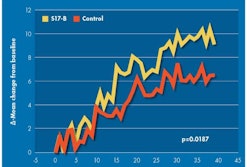Zinc is an essential dietary element that can be found in many natural mineral deposits. There are several forms available in the market that are used to supplement petfoods. This is done to complement the naturally occurring levels from the animal and plant sources found in common petfood ingredients. Finding the best options for your formulas is a matter of choice.
Zinc is commonly described as a transition metal with a valence of +2 which makes it biologically active. It is involved as a co-factor in more than 200 enzymes essential to body function and repair; everything from membrane integrity to the normal functioning of DNA and RNA. During digestion and absorption, zinc is thought to complex from the ionic form with a ligand (organic or inorganic) for transport throughout the system.
Zinc deficiency results in poor growth and skin lesions in dogs and cats; however, deficiency is not a practical consideration on typical pet diets. Diets high in poor-quality grain by-products or that contain factors which interfere with zinc absorption, like high calcium levels or phytate from seeds, may lead to insufficient zinc levels needed for normal skin and coat maintenance. There are also some northern breeds of dogs that are thought to have higher zinc needs to maintain the cornified tissue of the foot pad and overall coat condition. Zinc is also involved in reproduction and immune function and, when provided in a certain form, may promote health benefits.
The zinc requirement for cats and dogs ranges between 60–100 mg/kg on a 4,000 kcal diet (NRC, 2006) which is relatively easy to meet. However, the AAFCO (2015) nutrient profiles for zinc are a bit higher (75 and 120 mg/kg DM for cats and dogs, respectively), supposedly factoring for the lower digestibility of petfoods. Natural sources rich in zinc include red meats like beef (90 mg/kg DM) and whole grains in the germ layer (e.g., wheat germ, 138 mg/kg DM). Protein meals such as poultry by-product meal (128 mg/kg DM) and fish meal (Menhaden, 111 mg/kg DM) can also be rich sources of zinc. Legume seeds like immature green peas (57 mg/kg DM) and other plants are a modest source. Poor sources of zinc are the flours and starches.
Even “whole prey” ranges between 50–125 mg/kg DM for rodents and birds, and 100–650 mg/kg for reptiles and amphibians (Derenfield, 2002). Thus it becomes apparent, when comparing requirements to availability in a healthy combination of ingredients, that some level of supplementation is needed to meet a complete and balanced claim. Given there is really no upper limit on zinc supplementation (NRC, 2006) despite the 1,000 and 2,000 mg/kg maximum for dog and cat foods identified by AAFCO (2015), dietary fortification well beyond the minimum is relatively safe.
Supplemental forms are numerous . For the most part, they all start with mineral ore deposits. Mankind has a long history with zinc, where it was first added to copper to make the alloy brass ca 1,000 BC. This blue-gray metal was isolated by the German Andreas Marggraf in 1746. Today it is mined from sphalerite (ZnS, zinc sulfide), smithsonite (ZnCO3, zinc carbonate) and zincite (ZnO, zinc oxide) mineral ores found in deposits resulting from volcanic activity and hydrothermal systems, limestone and dolomitic rock, and sedimentary rock formations. These mined ores are refined, purifie, and modified through various inorganic chemical processes into forms that are usable for foods and nutrition purposes. Zinc used for “galvanizing” applications accounts for most of the zinc consumption (85%), followed by brass production (6%) as a distant second and production for oral consumption is insignificant in the total (USGS, 2012).
The zinc in galvanized food and feed containers and the coating on chain-link fences can supply a sufficient dose of zinc simply by licking these metal objects and enclosures. For more deliberate dietary purposes, supplemental sources include zinc acetate, zinc carbonate, zinc chloride, zinc oxide, zinc sulfate monohydrate and the chelated minerals (See Petfood Industry magazine, May 2008) like zinc proteinate, zinc propionate, zinc methionine, zinc glycine, zinc gluconate, zinc stearate and zinc yeast.
For decades, the most commonly used zinc sources have been the inorganic zinc oxide, zinc chloride and zinc sulfate. They have been confirmed through dozens of research studies to be effective for use by pets. More recent mineral nutrition research has evaluated the “organic” or “chelated” zinc forms as options for petfood fortification. The work has generally shown the organic form to be slightly more bioavailable, improve hair condition and improve reproductive efficiency (Lowe et al., 1994; Lowe and Wiseman, 1998; Brinkaus et al., 1998; and Kuhlman and Rompala, 1998).
Whether these results are observed in a home or kennel setting has not been confirmed. The cost differential can be insignificant in the final product so some companies promote the use of these organic zinc forms as an added value to their product. To date, no food functional benefit has been identified with the organic minerals, so their use may be solely as nutritional and market differentiators.
These zinc sources are all very concentrated, so the amount needed to fully fortify a diet is relatively low (parts per million) and are best managed in a trace mineral premix to aid in uniform distribution. At these low levels, flavor is not affected and other food interactions are generally assumed to be very low to negligible.
When making the choice on source, it is typically a decision between geographic availability and price. The key to remember is that zinc requirements in the diet can be supported by a wide array of supplement sources and each has been evaluated for its utility, biological availability, safety and nutritional benefit to the animal. The real decision on which one to choose comes down to the value that the ingredient provides to merchandising a given food to the pet owner and the rationale for why it was chosen over another. Choice is good.

















